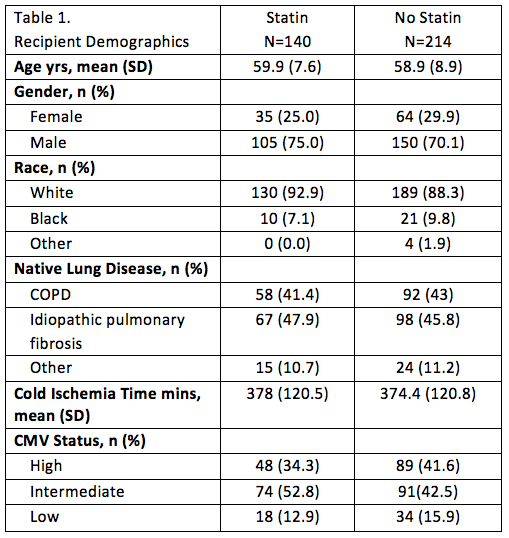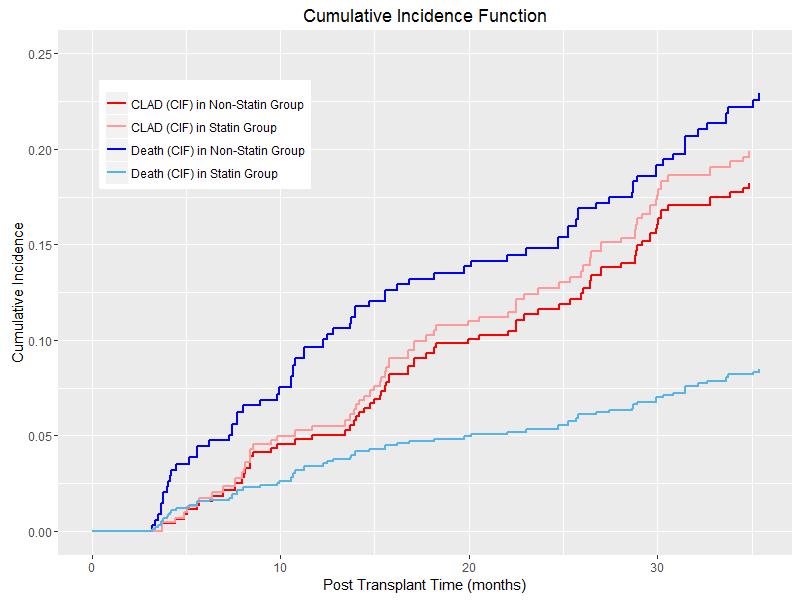Role of HMG CoA Reductase Inhibitors on Time to Development of Chronic Lung Allograft Dysfunction Post-Lung Transplant.
Duke University Hospital, Durham, NC
Meeting: 2017 American Transplant Congress
Abstract number: B250
Keywords: Graft arterlosclerosis, Graft survival, Obilterative bronchiolitis, Survival
Session Information
Session Name: Poster Session B: Lung Transplantation Poster Session
Session Type: Poster Session
Date: Sunday, April 30, 2017
Session Time: 6:00pm-7:00pm
 Presentation Time: 6:00pm-7:00pm
Presentation Time: 6:00pm-7:00pm
Location: Hall D1
Purpose: Five-year survival after lung transplant (LT) is approximately 55%. Chronic lung allograft dysfunction (CLAD) is a primary contributor to this reduced survival post-LT. Options are limited for prevention and treatment of CLAD. Literature suggests HMG CoA reductase inhibitors (statin) may play a role in delaying the development of CLAD via immunomodulatory effects. The aim of this study is to evaluate the role statins have on time to development of CLAD in LT patients.
Methods: Adult bilateral lung transplants between January 2004-October 2013 were included. The cohort was divided into statin and no statin groups and matched on age, gender and native lung disease. Statin patients were defined as having initiated a statin within 3 mos post-transplant with duration of at least 6 mos. Exclusion criteria included multi-organ, single-lung, re-transplant or ≤ 90 days survival post-transplant. The effect of statin on development of CLAD at 3-yrs while controlling for acute rejection and CMV pneumonitis was evaluated by competing risk approach.
Results: 354 patients were included: 140 statin and 214 no statin. Table 1 describes demographics, which are not statistically different in the weighted sample. Cumulative incidence of CLAD at 3 yrs for statin and no statin patients are 19.9% (95% CI: 11.8%-33.5%) and 18.2% (95% CI: 12.2%-27.3%), Fig 1. Statin use is not associated with a decrease risk of CLAD (HR: 0.95, 95% CI: 0.57-1.59,p=0.84) but is associated with a decrease risk of death (HR: 0.35, 95% CI: 0.19-63,p=0.0005). At 3 yrs patient survival was 82.1% in the statin group and 66.4% in the no statin group (Log-rank test p=0.0014).
Conclusion: Statins did not significantly delay the time to development of CLAD in lung transplant patients. However, a benefit in patient survival was demonstrated in patients receiving statin therapy.

CITATION INFORMATION: Szczepanik A, Hulbert A, Lee H, Benedetti C, Snyder L, Byrns J. Role of HMG CoA Reductase Inhibitors on Time to Development of Chronic Lung Allograft Dysfunction Post-Lung Transplant. Am J Transplant. 2017;17 (suppl 3).
To cite this abstract in AMA style:
Szczepanik A, Hulbert A, Lee H, Benedetti C, Snyder L, Byrns J. Role of HMG CoA Reductase Inhibitors on Time to Development of Chronic Lung Allograft Dysfunction Post-Lung Transplant. [abstract]. Am J Transplant. 2017; 17 (suppl 3). https://atcmeetingabstracts.com/abstract/role-of-hmg-coa-reductase-inhibitors-on-time-to-development-of-chronic-lung-allograft-dysfunction-post-lung-transplant/. Accessed December 29, 2025.« Back to 2017 American Transplant Congress
